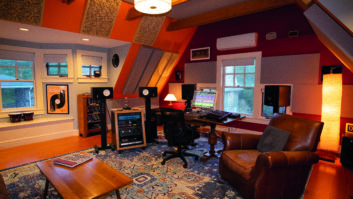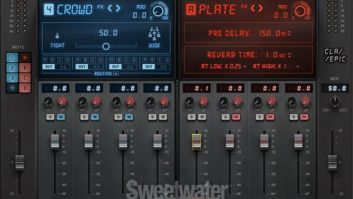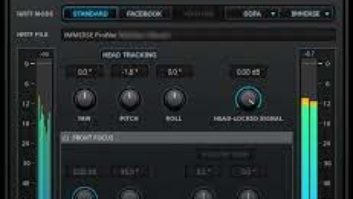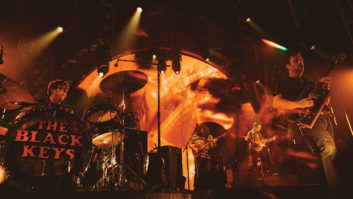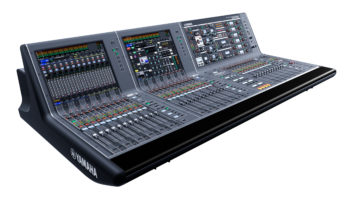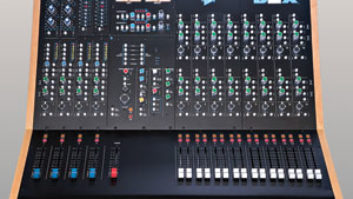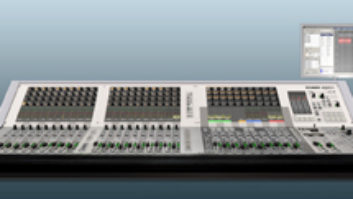by Christopher Walsh.
The console’s evolution toward a smaller footprint and DAW integration fits with the trend toward personal studio environments. But commercial studios are also taking to small-format consoles, often for the same reasons private studio owners have done so.
Manufacturers historically known for large-format consoles now offer a small-footprint version–or an evolved product adapted for modern production techniques–and commercial audio providers are taking to them. At a fraction of the cost of a large-format console, these new offerings are attractive from the start, but the small-format console is emerging as the practical contemporary-production solution for other reasons, too.
Jim Zumpano’s ZAC Recording complex was the first commercial facility in the U.S. to install AMS Neve’s Genesys console. “It’s working out well,” he reports. “From where I was–I had a [Digidesign] ProControl in that room–it has made quite a mark. We’re already seeing the results, the difference from trying to get the ProControl’s output tuned right through the speakers. This is much easier, it’s much more full and open and ‘Neve-ish,’ I guess you could say. It’s definitely given the sound presentation a much better outlook.”
The Genesys, Zumpano explains, is housed in the medium-size ZAC Digital room. “Everybody’s watching money,” he observes, “and seeing how people work–these large-format consoles, even on my SSL 4088 G+, I’ll walk in there 80 percent of the time and two faders will be up. It didn’t make sense.
“For the past three years of AES,” he adds, “I’d been looking for a solution outside of that ProControl. The Dangerous boxes were an option at one point, [but] for a commercial studio, there’s a certain amount of client impression that needs to be done. The other really big deal was, I needed some analog channels. We do a lot of hip-hop tracking, and I always had to pull in a bunch of Eclipse [Audio, ZAC’s rental division] mic pres and whatnot, and it was always a big mess of cables to get something decent. Some of the guys just forego all of that and were going straight into Pro Tools and dealing with it like that, so I wanted a way to deal with analog channels.”
Rockland, Mass.-based Professional Audio Design had demonstrated the Genesys in 2008. “We all looked at it,” Zumpano recalls. “I personally was like, ‘This is the thing.’ It’s a very concise console, I’ve got 24 channels, and it’s smaller than that Argosy/ProControl scene that I had. It fits in the room really well. I’ve got the power of the Neve preamps, and I got it loaded with 16 channels of the EQ, just to get started. I liked the expandability of it–I got a 32 frame. I’m testing the waters with this basic setup, and people are really digging it. A couple of my rock friends have been mixing in the box, and this is the breakout box. This is a great complement to the rest of the stuff that we’ve got. It was the right combination of Pro Tools and analog. Most people are in the box, but guys that want to sit there and work can work it, work their plug-ins and all of that, and be sitting at a nice analog desk. That was another big factor in making the choice.”
Mark Alan Goodman is “freaking out on” the API 1608 with which he opened Strange Weather in the Williamsburg section of Brooklyn. Goodman was leaning toward a vintage console, having long worked at nearby Studio G, which over a decade had housed a Soundcraft Ghost, an Auditronics and, presently, a Neve 5316.
“I’ve always loved working on APIs,” he says, “and was really excited by the fact that it’s really the same circuitry they’ve been using since the Seventies. Really, nothing changed in the signal path; there’s a couple of new routing options, but it’s the same console, just repackaged nicely and appropriately for work in Pro Tools.”
The 1608’s cost and expandability were important factors in his decision, Goodman adds. “I really liked the fact that I was able to expand it. That was one of the initial considerations, because I started out with just 16 channels–now it’s at 32. It was a cost consideration, for sure, because it’s a small studio. I’m not trying to jump in to the deep end too hard–I’ve just seen so many bigger studios losing money over the last couple years. Places the size of Studio G or Strange Weather–smaller spots–are picking up work here and there, being able to work with people’s new formats. People who work at home, when they want to come in and do something in a studio, that’s the kind of room they want to go to. They don’t need to spend $2,000 a day.”
Large-format consoles, says Doug McBride of Chicago’s Gravity Studios, “don’t make as much sense as they used to. I didn’t really even consider them.”
Last year, McBride acquired a Rupert Neve Designs 5088 console. “There’s a lot of hidden costs associated with a full, old-fashioned, giant console,” he notes. “I think some people jump into the studio business and assume they need one, buy a giant one, and then find out–fast. I don’t want to have a full-time tech on my staff. I don’t want giant electric bills.
“We use Pro Tools|HD,” McBride adds, “but I’m a pretty big fan of analog gear in conjunction. So one of the biggest things for me was the EQs–I’m used to having the power of the EQ in the sweet spot. There were some consoles available that had everything in front of you except the EQ. I didn’t just want to have broad-stroke EQ–like we had previously–I wanted surgical EQs. The five-band EQs in this console are just phenomenal, very powerful. That was a big part of it.”
In Santa Barbara, Calif., Tucker Bodine opted for a Solid State Logic AWS 900+ console for his Playback Recording Studio, which offers post production and music recording services.
“I considered a lot of options,” Bodine confides. “I definitely knew I wanted an analog console. I looked at a lot of older SSLs and Neves, with Vintage King and a few other people, and getting a 72-input console. The problem was they didn’t have the DAW features to run Pro Tools. I also went down the road of trying to get the Neve [Genesys] and a [Digidesign] ICON and putting them side by side, which I see a few studios have done. But I didn’t want two consoles.
“At the studio I had before,” he explains, “I had a [Digidesign] Control24, and I worked on ProControls at a lot of studios. I got kind of spoiled with being able to DAW Pro Tools so easily, so I wasn’t about to go in reverse.”
Bodine narrowed the search to the Wunder Audio Wunderbar, the Genesys, the Tonelux console and the AWS 900+. “After narrowing all that down,” he says, “the AWS just broke out in front. I always loved working on SSLs. Plus, with an AWS in the room I have an ‘SSL studio.’ I racked up a bunch of Neve mic pres, and that pretty much filled the Neve craving.
“Budget-wise and for what you get,” Bodine adds, “there’s still nothing that rivals the AWS on the market. It comes with SSL’s tech support and a company you know is going to be around–not that the other ones aren’t, but that was heavily considered too. Every studio I’ve ever been to in New York has, like, four SSL rooms and a Neve room. I kept thinking, ‘I’m only doing a one-room facility, so my main room is an SSL room.’”
AMS Neve
www.ams-neve.com
Rupert Neve Designs
www.rupertneve.com
Solid State Logic
www.solid-state-logic.com
